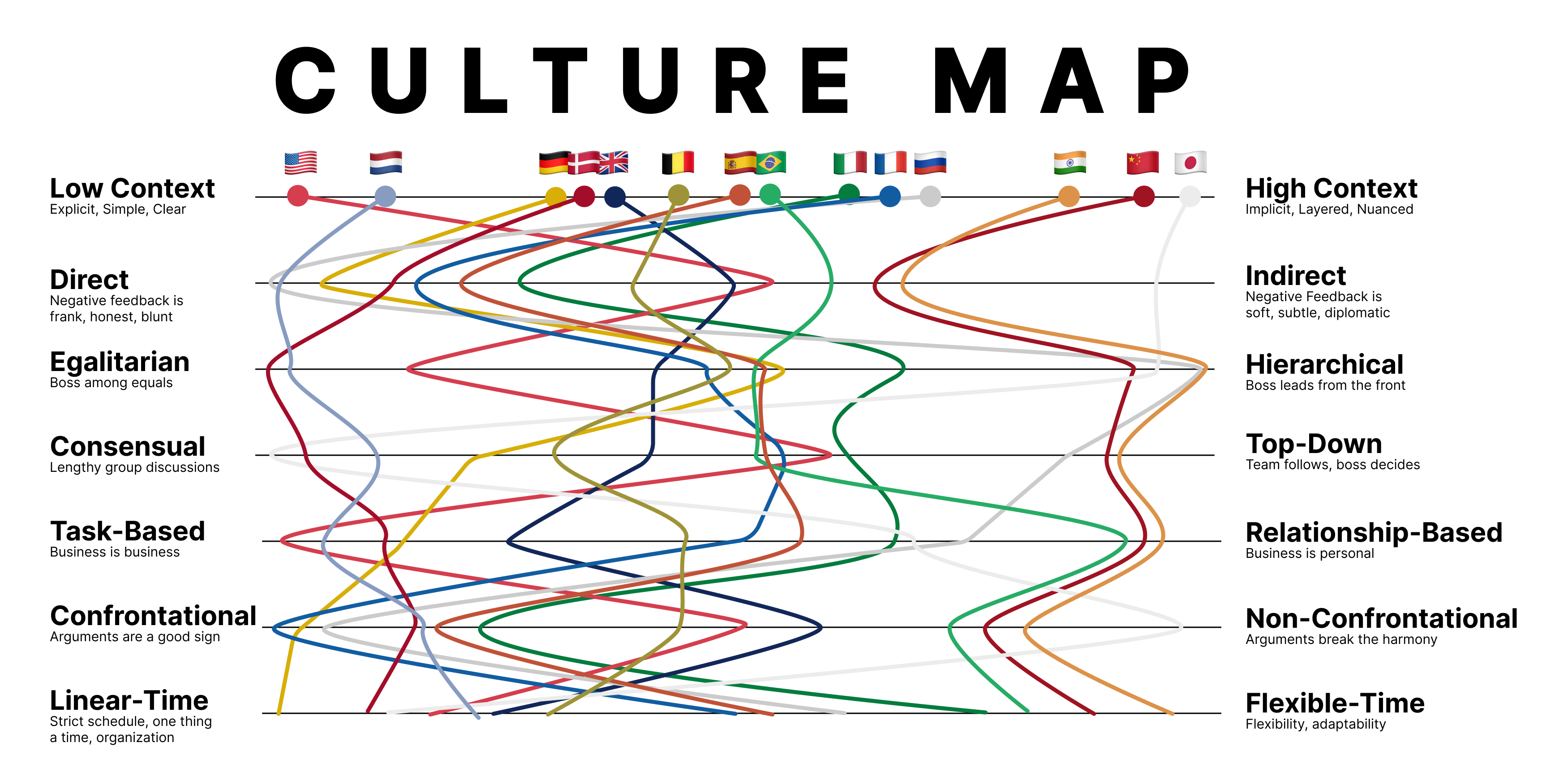Cultures can be very different
One of my favorite lessons in my international master’s course was about cultural differences. I remember our instructor showing us funny videos of different cultures interacting. There was an American asking an Indian colleague if they’ll meet next week’s deadline. The response, “I’ll see what I can do” could mean either “sure” or “no way” depending on the cultural context. Needless to add that the American was very confused when the deadline wasn’t met the week after.
That’s because India is a high-context culture, where linguistic nuances are the norm. An Indian person won’t give us negative feedback directly. Instead, they use varying levels of complex analogies to provide indirect hints on how to improve. Compare this to a low-context Swedish person. He will be more likely to say “This system sucks” in a blunt and direct way.
Disclaimer on generalizations: It’s important to note that we’re discussing averages and general tendencies, not stereotypes. The country position on the chart indicates the mid-position of a range of acceptable or appropriate behaviors in that country! Of course, you’ll find diverse individuals within any culture. You should always evolve your understanding based on personal interactions.
Another example? Just take this viral meme about UK language (which is middle-high context)!
Another interesting aspect is the importance of relationships in different cultures. In China, it’s crucial to know the other person, share meals and drinks together. At the opposite, Nordic cultures like America and Germany prefer to focus on tasks. From both perspectives, their approach feels natural, but it’s deeply ingrained in their cultural norms.
And that’s great!
And that’s the fun part: we’re all different, and there’s no “right” or “wrong” way to communicate. Each of us has our own style, and each perspective makes sense in its cultural context. In the end it’s all about appreciating the rich diversity of human communication and adapting our styles accordingly.
I’ve always applied these lessons carefully, especially now that I work in a corporation with dozens of different cultures. I was able to connect more naturally and avoid many intercultural oopsie. Knowing cultures serves as a shortcut: if I’m talking with someone from a low-context culture, I can expect some sharp and direct comments. For a high-context culture, I need to be very careful and read between the lines.
Let’s take time perception as another example. A German person will usually be punctual, and punctuality is highly valued, while for a Brazilian, I know I can be more flexible with timing.
Erin Meyer’s “The Culture Map”
All these precious differences are explored in the fantastic book “The Culture Map” by Erin Meyer, which my professor suggested during the course and which I now highly recommend myself.
A unique strategy the professor used was to position each culture along a spectrum with two extremes. This creates a structured framework to differentiate between them. During the past months, I recreated my own Figma diagram of the Culture Map, including cultures I’ve personally interacted with. This gives me a quick visual reference of their (average) cultural traits, blending Meyer’s insights with my own experiences.
Png version:
Here’s an explanation of each point on the Culture Map so you actually know what’s going on:
Communicating
Low-context: Good communication is precise and straight to the point. Key messages are repeated several times, and the goal of communicating is explicitly expressed, as it happens in the 🇺🇸.
High-context: Communication is nuanced and has multiple layers. Messages are signaled but often not explicitly stated. This type of communication requires “reading between the lines”. For example, 🇯🇵, where there’s even a specific word for this concept: 空気くうきを読よむ, “Reading the Air”. It’s vital skill to understand the subtle nuances of a situation and respond appropriately.
Evaluating
Direct negative feedback: Honest, straightforward feedback is expected, even in front of others. This is common in 🇳🇱, though it’s not always linked to low-context cultures (In contrast, 🇺🇸 tends to soften negative feedback).
Indirect negative feedback: Feedback is delivered diplomatically, often in private. Negative feedback is cushioned with compliments or spread out over time, for example, in 🇨🇳.
Leading
Egalitarian: Leaders are seen as equals, guiding rather than directing. In 🇳🇱, for example, it’s not uncommon to see a Prime Minister biking to work, emphasizing the leader’s equal footing with the public. Hierarchical: Leaders hold clear authority and are expected to make decisions. Subordinates defer to their leadership. 🇷🇺 is a prime example of a hierarchical culture.
Deciding
Consensual: Decisions are made with input from various participants. This isn’t always tied to egalitarian cultures like 🇩🇪. For example, in 🇯🇵, where leadership is hierarchical, decisions are still discussed across levels before finalization.
Top-down: Decisions come from the top and are passed down through the ranks. This what happens in 🇨🇳.
Trusting
Task-based: Trust is built through competence. If someone proves capable, they are trusted, and work relationships can be easily formed or dissolved. 🇫🇮 culture is very pragmatic about this aspect.
Relationship-based: Trust is developed through personal connections, often built through shared experiences like meals and socializing. Only after personal trust is established will business proceed. Common in Middle Eastern cultures like 🇸🇦.
Disagreeing
Confrontational: Open debate and even confrontation are seen as vital for ideas to flow. Animated discussions are encouraged to refine solutions. See 🇮🇱 as example.
Avoids confrontation: In high-context cultures, direct confrontation is seen as disruptive to group harmony. A person from 🇮🇩 may offer subtle hints rather than disagreeing openly.
Scheduling
Linear-time: Punctuality and sequential task management are key. Projects are handled one step at a time, with strict adherence to schedules. 🇨🇭 is often cited as the epitome of linear-time culture.
Flexible-time: Schedules are fluid, with meeting times seen as flexible. Conversations and tasks often shift direction depending on the situation. A good example of a flexible-time culture is 🇰🇪.
